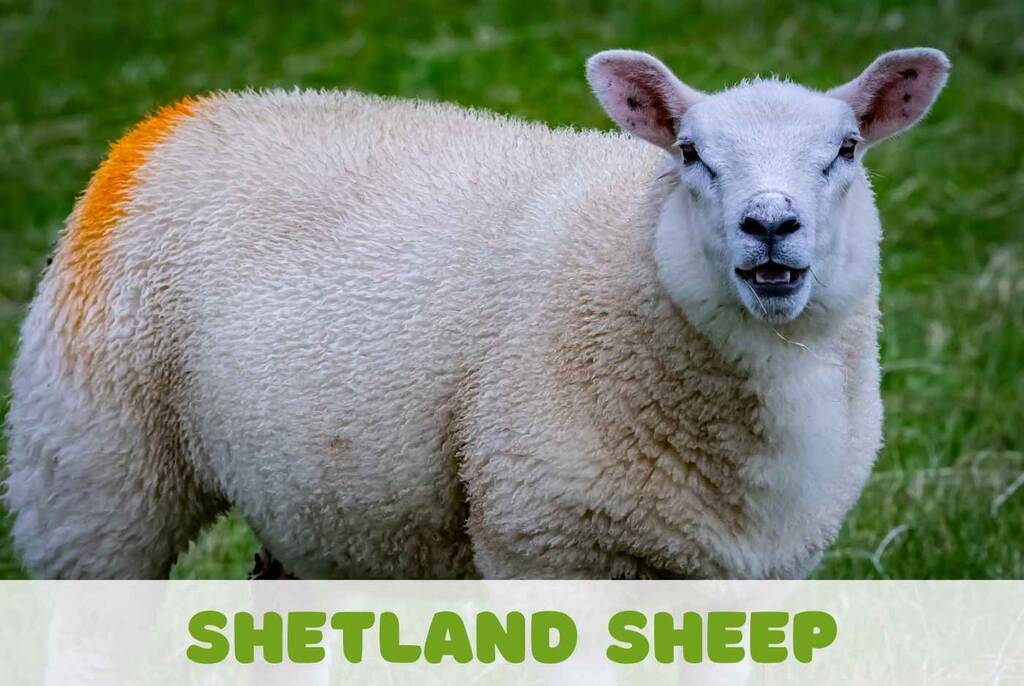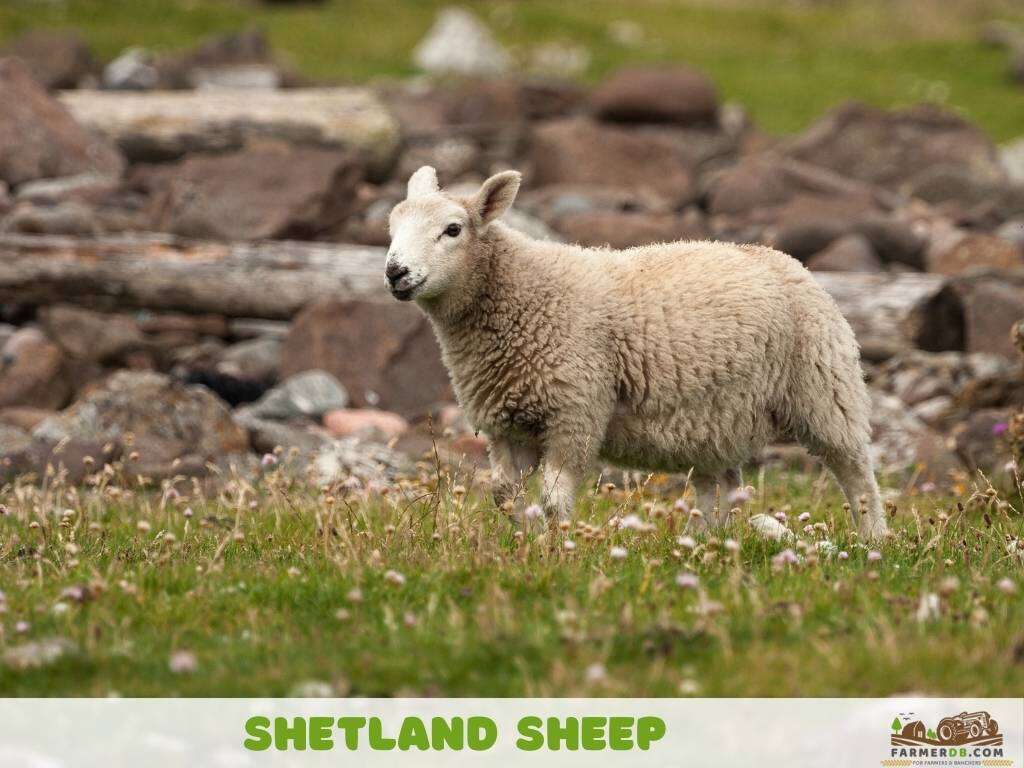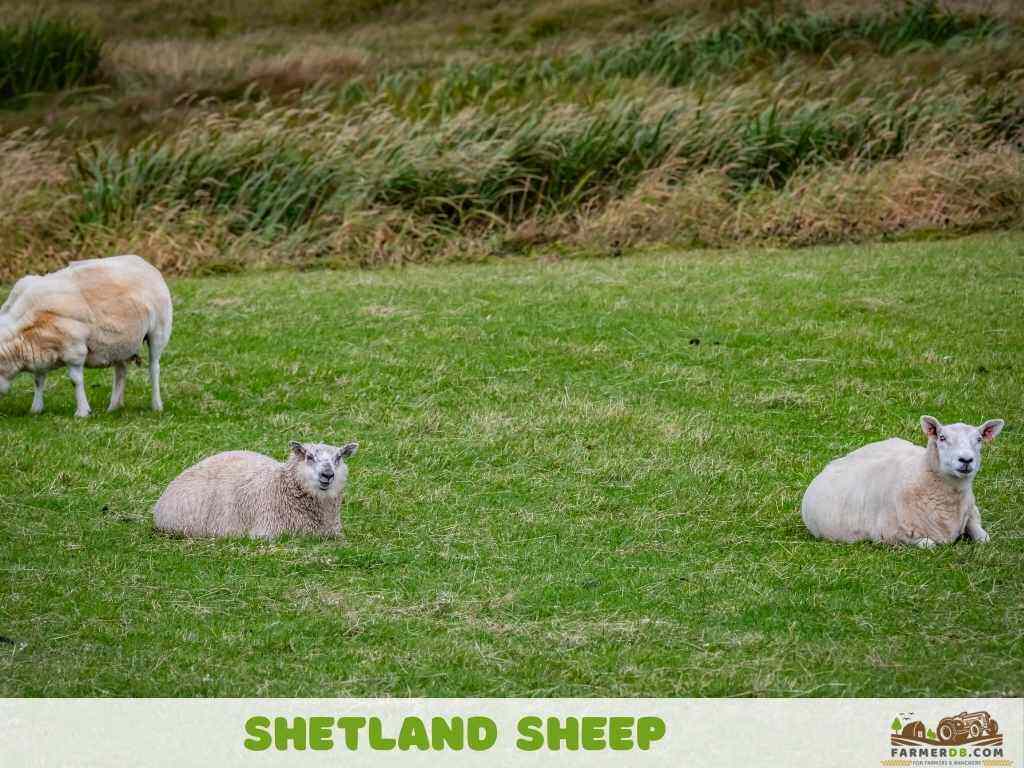The Shetland sheep is a primitive sheep breed that has adapted to and been shaped by the local environment and practices, without going through a modern selective breeding process.

Contents
Characteristics
Size
This type of sheep is known for its small size, being widely known as one of the smallest sheep breeds.
The height of a Shetland sheep at the shoulder ranges from 18 to 24 inches (46 to 61 cm), with a length from the tip of the nose to the base of the tail measuring 36 to 48 inches (91 to 122 cm).
Do not forget that individual variations may exist, and their measurements can be influenced by factors such as age, gender, nutrition, and management.
Color
They come in a variety of colors, including white, black, moorit, silvery gray, fawn, gray, and dark brown.
It is also common for these sheep to have different patterns, such as spots, speckles, and other markings.
The color of the skin varies depending on the color of the fleece.
Fleece
The fleece can be white, black, or various shades ranging from gray to brown. It covers the entire body, including the tail, as well as part of the forehead and a section of the legs.

The fleece can have various markings, some of which are given specific names.
- Bielset – a sheep with Bielset marking displays a full circular band of black around its neck.
- Blaget – white with uneven dark patches, resembling a ground partially covered with snow.
- Bleset – a dark hue with a white stripe down its forehead. Also, this particular Bleset possesses the spotting gene, evident from the spots on its muzzle.
- Flecket – a white coat with black or brown patches on the body. These spots are not as clearly defined as those seen in Jacob Sheep.
- Fronet – black coat with a white head and black spots around the eyes.
- Gulmoget – a dark-colored body with light underparts. The face also has some markings that resemble a mouflon-like pattern observed in Mouflon and Soay sheep.
- Iset – dark coat with a lot of white fibers.
- Katmoget – a body of light color, featuring a dark belly and legs, along with the unique moget-face markings.
- Mirkface – white with dark patches on the face.
- Smirslet – a dark color with white around the mouth, and sometimes a thin line of white goes up to the top of the head.
Head, Ears, Face, Eyes
The sheep has a medium-sized head with a lively and alert expression. The bright eyes are well-spaced.
The ears are also medium-sized, placed slightly above the horizontal. The face is clear, except for wool on the cheeks and a tuft on the forehead.
The overall face profile is straight, without a Roman nose or overly dish-faced features. The most noticeable characteristic is the hollow between the cheeks and nose.
Horns
The presence of horns depends a lot on the sex. Most Shetland rams have horns, but there are also polled rams, and they are acceptable when registering one. On the other hand, the ewes are usually polled, with only a small share having horns.
The ram’s horns are rounded in sections and develop a spiral as they grow with age, curving above the head. The horns should not touch the face, and this should be checked and corrected if necessary to prevent posing a threat to the ram’s life.
Regarding the ewes’ horns, these are more delicate and lack a spiral. They rise up and off the head in a single plane.
Neck, Shoulders, Chest
These sheep have a nice, full neck that smoothly goes into a wide chest. Their shoulders are well-placed and level with the back, making a well-balanced body. The chest is not too wide but has good depth, adding to their strength and overall look.
Back, Ribs, Rump
They have a straight back that is wide, giving them a strong appearance. Their ribs are well-spread and nicely shaped, contributing to their well-proportioned bodies. The rump is also wide, with rounded hips, enhancing their overall strength and appearance.
Tail
The tail is one of its most crucial physical features. Covered in wool, it has a fluke shape-broad at the base and narrowing to a flat, hairy tip. The tail is about 4 to 5 inches (10 to 12 cm) long and rarely exceeds 6 inches (15 cm).
Lifespan
Shetland sheep can live for 12 years, but it is also common for them to outlive this lifespan.
There have been cases recorded of them living up to 20 years.
Growth Rate
How fast do they grow?
These sheep do not grow fast.
They have a slow growth rate and can reach their final weight at 1.7 to 1.9 years old.
Sexual maturity is achieved earlier at about 10 to 12 months old.
You also have to consider factors such as genetics, nutrition, management, and the overall health of the sheep, as these influence the growth rate.
Weight
These sheep generally weigh between 75 and 120 lbs (34 to 54 kg).
A fully mature ram weighs between 90 and 120 lbs (41 to 54 kg), while a fully mature ewe weighs between 75 and 100 lbs (34 to 45 kg).
They follow the same pattern as in many other sheep breeds, such as Australian White sheep, where the ewe is smaller than the ram.
Slaughtered age
You can butcher them at one year old when they reach a weight of 100 lbs (45 kg).
But, waiting longer than one year is also acceptable. Due to their slow growth, delaying the butchering process will result in more flavorful meat.
Shearing
You need to shear these sheep once a year in the spring.
If you plan to use their wool, it is important to keep the sheep under your observation and plan the shearing correctly.

These sheep have a natural mechanism for shedding their fleece when a shearer is not around. This helps them stay cool as the weather becomes warmer. If you wait too long, their natural fiber starts breaking off.
Shearing a Shetland sheep needs to be done carefully, as the sheep tends to get scared. But, if you ensure the well-being of the sheep, everything becomes easier. Here is a short guide on how to shear these sheep:
- To get the best wool, it is recommended to clean and dry the sheep before shearing. But if the sheep is not dirty, you can proceed to the next step.
- Gather all the tools you need, including electric shears or hand shears, a comb, and cleaning tools for the electric shear.
- Make sure the sheep is comfortable, feels safe, and is secure to stay still during shearing.
- Start shearing from the belly and inner thighs, moving towards the neck and back.
- Try to avoid cutting the sheep or leaving uneven patches of wool.
- Pay attention to the natural contours of the sheep’s body to achieve an even shearing job.
- As you shear, check the wool for any signs of contamination, such as feces or debris. Remove any contaminated wool to maintain quality.
Temperament and Behaviour
Shetland sheep are friendly, calm, and approachable animals, making them easy to manage.
These sheep are quite curious and have an instinct to explore their surroundings, sometimes attempting to jump over the fence and escape.
They are also capable of forming a special bond with their caretaker, who feeds them, takes care of them, or assists them during lambing. Ewes, in particular, can learn to recognize a person and respond positively to their familiar face or voice.
Grazing is one of their favorite activities, and they can engage in it all day long.
When it comes to rams, they can be challenging to handle during the breeding season. During this time, they tend to become more aggressive, seeking dominance to access ewes for mating. It is crucial to be cautious around them, and if not necessary, avoid touching or petting them. Never turn your back on rams, as despite their smaller size, they can cause harm.
Avoid leaving young kids around rams, especially during the breeding season. Take precautions to prevent potential risks associated with the rams’ aggressive behavior.
Apart from the breeding season, rams are calm and much more delightful to handle.
Usage
You can use these sheep for meat and wool, but some farmers also choose them for conservation grazing.
Meat
The meat is very lean because these sheep store most of the fat around their organs, resulting in lean muscles. It is tender, with a mild flavor and fine texture.
If the meat comes from a sheep older than 2 years, known as mutton, it has a richer flavor and greater tenderness. Chefs typically prepare mutton by marinating it first and then cooking it slowly.
Wool
The wool is highly valued by hand-spinners, especially since it comes in various colors and types. There are three recognized types of Shetland wool:
- Kindly or single-coated fleece, soft and 2 to 4 inches long.
- Wavy fleece, slightly longer at 4 to 6 inches compared to the single-coated one.
- Double-coated fleece, the longest at 6 to 10 inches or more.
The single-coated fleece is excellent for next-to-skin garments, while the double-coated and wavy ones are suitable for worsted spinning and knitwear.
The weight of the wool is typically 2-5 lbs (0,90 – 2,26 kg), with a usable fleece percentage between 65-80%.
Fiber thickness ranges from 20-30 microns, with some as fine as 10-20 microns and others as coarse as 30-60 microns or more. The Shetland Sheep Society in the U.K. notes an average fiber diameter of 23 microns.
The lanolin on the wool may make it appear darker and more yellowish than it actually is. After washing, the wool appears lighter and whiter than in its raw state.
Shetland wool of good quality has a price of $16 to $30 per lb.
Conservation grazing
Conservation grazing is one last use of Shetland sheep. Farmers prefer using these sheep to control vegetation on the farm. Due to their grazing habits, they help prevent the overgrowth of vegetation and maintain biodiversity by consuming dominant plants and promoting the growth of other plant species.
Their ability to graze in different landscapes, from rough to less fertile terrain, makes them valuable for conservation efforts.
Raising
Raising these sheep is easy and manageable, making it an ideal hobby even for those new to growing sheep.
Feeding
You can feed them fresh grass from the pasture during the warm season and grains or hay during the cold season.
During spring and summer, you can allow the sheep to graze freely. It’s always important to inspect and monitor the pasture for poisonous plants. Sheep avoid consuming poisonous plants unless there are no other food options available.

When the pasture quality declines, it’s best to supplement their diet with hay or grains. I recommend gradually introducing hay or grains into their diet, adding small amounts, and then increasing the quantity.
The same principle applies when transitioning back to grazing in the warmer season after months of being fed only hay. Avoid letting them graze excessively on the first day. Instead, allow them to graze for about 20 minutes on fresh grass and then return them to their regular hay diet. This helps prevent bloating and reduces the risk of veterinary expenses.
How many per acre?
You can raise 10 to 15 sheep per acre.
Environment
Shetland sheep should be raised in an open environment with access to pasture. They love to be free, graze, run around, and explore. All these activities allow them to consume their high levels of energy. Even during the coolest temperatures, these sheep stay outside most of the time, gathering together in the shelter only at night.
Climate
They can adapt to a variety of climates, from the coldest to the warmest. They thrive in regions with cool temperatures, abundant rainfall, and high-quality pasture, such as temperate maritime climates.
These sheep can also adapt to extremely hot or arid climates.
Despite their long and thick fleece, which helps regulate temperature, they can maintain their body temperature at moderate levels.
With the right shelter, nutrition, and access to fresh water, you can successfully raise them in any climate.
Shelter
Shetland sheep need shelter. Even though they are hardy animals and can resist colder temperatures, they need shelter to protect them from predators and harsh weather conditions such as torrential rain, powerful winds, or large amounts of snow.
If you live in an area with potential predators, you should build a four-sided structure and secure them inside at night. If your area is relatively safe, a three-sided structure will work.
The shelter doesn’t need to be very spacious, as these sheep will only stay there at night. They prefer spending the entire day outside. However, you must ensure that the ventilation is excellent, as poor ventilation can negatively affect the sheep’s health.
In addition to the shelter, you will need a reliable electric fence to prevent them from escaping and to keep predators out.
Breeding
These sheep breed easily through natural mating.
They are seasonal breeders and become fertile in October and November. Ewes are in heat for 28 hours and have a 16 to 17-day cycle.
The gestation period is 148 to 152 days. If you breed them in October, you can expect your first lambs in the spring.
Ewes do not need assistance during birth and can raise their lambs on their own. All you need to do is prepare a separate space for them. The ewe, with her natural mothering instincts, will take care of the rest.
One great thing about these sheep is that ewes can be bred until they are 10 to 12 years old.
Health Issues
Even though they are hardy animals with very high parasite resistance, they can still experience some health issues throughout their lives. Some of the most common health issues include:
- Pneumonia, especially if the shelter is not well-ventilated.
- Nutritional deficiencies if their diet lacks certain vitamins or minerals.
- Sheep scab or Psoroptic Mange, a skin disease caused by mites.
Vaccination
You can choose to vaccinate your sheep by administering vaccinations biannually. Some farmers opt not to do so, so it all depends on your farm management.
It is also recommended to deworm the sheep based on the region you live in for optimal health.
Be mindful of their feet. I recommend inspecting their feet twice a year and trimming them if necessary.
Why should you raise them?
Shetland sheep are excellent choices for homesteaders seeking a hobby or a meat source, but not for those considering going into a business, as their behavioral traits and energy levels make them unsuitable for confinement.
Their small size means you don’t need large pastures or shelter, especially considering their resilience to various climates.
Due to their grazing habits, these sheep mainly need fresh grass and don’t rely heavily on grains or hay. They’re good at breeding and taking care of their young without much help.
Overall, they are easygoing animals ideal for homesteaders, providing both meat and wool for crafting projects.
Advantages
- High-quality fleeces
- Great meat
- Dual-purpose (Meat and Wool)
- Economical to keep
- Good mothering skills
- Effective in weed and undergrowth control in pastures and orchards
- Unique Wool Qualities
- Available in all regions of the United States and several Canadian Provinces
Disadvantages
- Require annual shearing
- Susceptible to predators
- Do not offer a substantial amount of meat yield.
- Need to protect some trees and bushes from sheep browsing
History and Origins
The Shetland sheep’s history began over 1,000 years ago on the Shetland Islands, where they were brought by Viking settlers. These sheep were part of the Northern European short-tailed group, which includes other breeds such as Finnsheep, Norwegian Spaelsau, Icelandics, Romanovs, and more.
They lived and bred for centuries without any issues until the 1900s when they were crossbred with other sheep breeds to increase wool quality and production. Gradually, the short-tailed sheep were replaced by long-tailed types, and purebred Shetlands became very rare.
The crossbreeding had a significant impact on this sheep breed, bringing it close to extinction. What saved it was the establishment of the Rare Breed Survival Trust, which aimed to preserve native sheep breeds in the UK.
Simultaneously, Colonel G. D. Dailley of Cambridge, Ontario, Canada, discovered these sheep and decided to export them to North America. In 1970, Dailley took 28 ewes and 4 rams by plane to Canada, and in 1986, the first flock of purebred Shetland sheep was established in the United States.
Currently, the status of Shetland sheep is categorized as “in recovery.”
Do you have any experience with the topic discussed here?
Would you like to improve the information shared and contribute your practical knowledge on the subject?
Your real-world experience as a farmer or rancher could greatly benefit other members, and the community would deeply appreciate your contribution.


